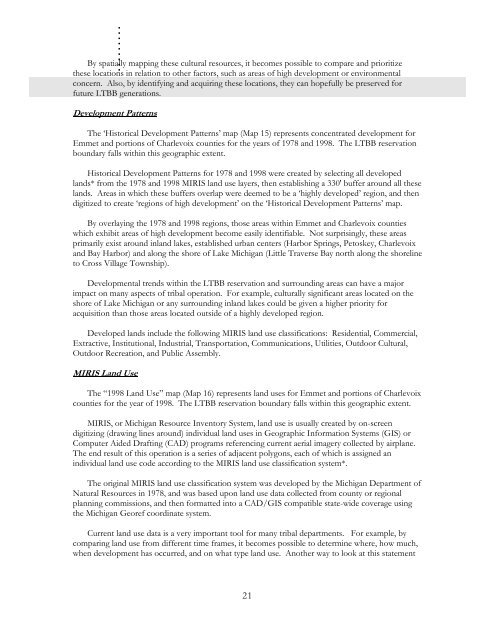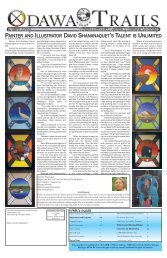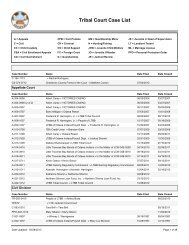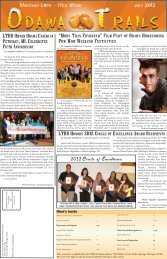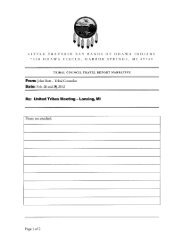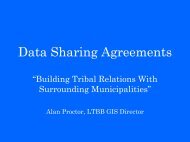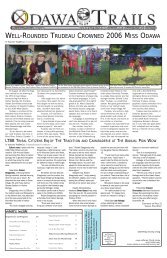LTBB Master Land Use Plan - Little Traverse Bay Bands of Odawa ...
LTBB Master Land Use Plan - Little Traverse Bay Bands of Odawa ...
LTBB Master Land Use Plan - Little Traverse Bay Bands of Odawa ...
Create successful ePaper yourself
Turn your PDF publications into a flip-book with our unique Google optimized e-Paper software.
.<br />
By spatially mapping these cultural resources, it becomes possible to compare and prioritize<br />
these locations in relation to other factors, such as areas <strong>of</strong> high development or environmental<br />
concern. Also, by identifying and acquiring these locations, they can hopefully be preserved for<br />
future <strong>LTBB</strong> generations.<br />
Development Patterns<br />
The ‘Historical Development Patterns’ map (Map 15) represents concentrated development for<br />
Emmet and portions <strong>of</strong> Charlevoix counties for the years <strong>of</strong> 1978 and 1998. The <strong>LTBB</strong> reservation<br />
boundary falls within this geographic extent.<br />
Historical Development Patterns for 1978 and 1998 were created by selecting all developed<br />
lands* from the 1978 and 1998 MIRIS land use layers, then establishing a 330' buffer around all these<br />
lands. Areas in which these buffers overlap were deemed to be a ‘highly developed’ region, and then<br />
digitized to create ‘regions <strong>of</strong> high development’ on the ‘Historical Development Patterns’ map.<br />
By overlaying the 1978 and 1998 regions, those areas within Emmet and Charlevoix counties<br />
which exhibit areas <strong>of</strong> high development become easily identifiable. Not surprisingly, these areas<br />
primarily exist around inland lakes, established urban centers (Harbor Springs, Petoskey, Charlevoix<br />
and <strong>Bay</strong> Harbor) and along the shore <strong>of</strong> Lake Michigan (<strong>Little</strong> <strong>Traverse</strong> <strong>Bay</strong> north along the shoreline<br />
to Cross Village Township).<br />
Developmental trends within the <strong>LTBB</strong> reservation and surrounding areas can have a major<br />
impact on many aspects <strong>of</strong> tribal operation. For example, culturally significant areas located on the<br />
shore <strong>of</strong> Lake Michigan or any surrounding inland lakes could be given a higher priority for<br />
acquisition than those areas located outside <strong>of</strong> a highly developed region.<br />
Developed lands include the following MIRIS land use classifications: Residential, Commercial,<br />
Extractive, Institutional, Industrial, Transportation, Communications, Utilities, Outdoor Cultural,<br />
Outdoor Recreation, and Public Assembly.<br />
MIRIS <strong>Land</strong> <strong>Use</strong><br />
The “1998 <strong>Land</strong> <strong>Use</strong>” map (Map 16) represents land uses for Emmet and portions <strong>of</strong> Charlevoix<br />
counties for the year <strong>of</strong> 1998. The <strong>LTBB</strong> reservation boundary falls within this geographic extent.<br />
MIRIS, or Michigan Resource Inventory System, land use is usually created by on-screen<br />
digitizing (drawing lines around) individual land uses in Geographic Information Systems (GIS) or<br />
Computer Aided Drafting (CAD) programs referencing current aerial imagery collected by airplane.<br />
The end result <strong>of</strong> this operation is a series <strong>of</strong> adjacent polygons, each <strong>of</strong> which is assigned an<br />
individual land use code according to the MIRIS land use classification system*.<br />
The original MIRIS land use classification system was developed by the Michigan Department <strong>of</strong><br />
Natural Resources in 1978, and was based upon land use data collected from county or regional<br />
planning commissions, and then formatted into a CAD/GIS compatible state-wide coverage using<br />
the Michigan Georef coordinate system.<br />
Current land use data is a very important tool for many tribal departments. For example, by<br />
comparing land use from different time frames, it becomes possible to determine where, how much,<br />
when development has occurred, and on what type land use. Another way to look at this statement<br />
21


